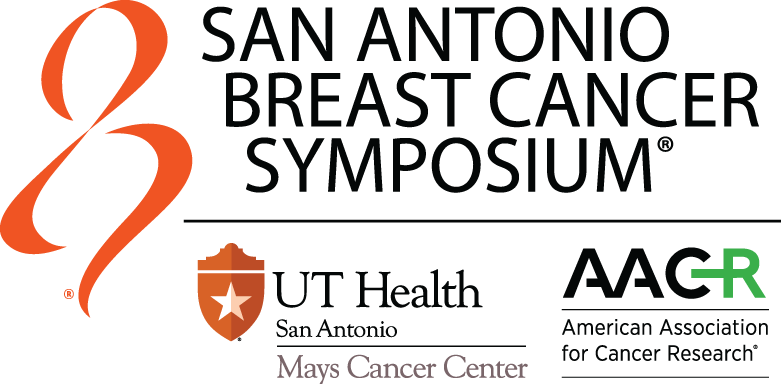The first General Session at the 2024 San Antonio Breast Cancer Symposium® included presentations and discussions on data from a phase III trial of a novel selective estrogen receptor degrader (SERD), long-term follow-up of the phase III OlympiA study of adjuvant olaparib, and an international cohort study of the impact of risk-reducing surgeries on survival outcomes in young women diagnosed with breast cancer with germline pathogenic/likely pathogenic BRCA1/2 mutations.
A recording of the session, held Wednesday, December 11, is available on-demand for registered 2024 SABCS® participants through March 31, 2025, on the virtual meeting platform.
GS1-01: Imlunestrant, an Oral Selective Estrogen Receptor Degrader, as Monotherapy & Combined with Abemaciclib, for Patients with ER+, HER2- Advanced Breast Cancer, Pretreated with Endocrine Therapy: Results of the Phase 3 EMBER-3 Trial

Komal L. Jhaveri, MD, the Patricia and James Cayne Chair for Junior Faculty, Section Head of the Endocrine Therapy Research Program, and Clinical Director of the Early Drug Development Service at Memorial Sloan Kettering Cancer Center, shared findings from the phase III EMBER-3 trial.
The data showed that imlunestrant, an investigational next-generation SERD, may improve progression-free survival (PFS) in patients with endocrine therapy-pretreated, estrogen receptor-positive (ER+), human epidermal growth factor 2-negative (HER2-) advanced breast cancer.
“We know that ER and CDK4/6 are critical oncogenic pathways and essential therapeutic targets [in ER+ HER2− advanced breast cancer],” Dr. Jhaveri said. “Even beyond progression [on endocrine therapy and CDK4/6 inhibitor treatment], they remain important therapeutic strategies.”
The CDK4/6 inhibitor abemaciclib has demonstrated activity in both CDK4/6 inhibitor-naive and-pretreated patients. Among ER-targeted approaches, fulvestrant is the only SERD currently approved broadly as monotherapy and in combination.
“But the efficacy [of fulvestrant] is limited in patients with ESR1 mutations and because of the requirement for intramuscular administration, it can be often painful and burdensome to our patients,” Dr. Jhaveri said.
Dr. Jhaveri differentiated elacestrant, an oral SERD approved as monotherapy for patients with ESR1 mutations, from the next-generation oral SERD imlunestrant, pointing out the latter agent’s central nervous system penetrance and mechanism of pure ER antagonism that allows for continuous ER inhibition.
In EMBER-3, 874 patients with ER+, HER2- advanced breast cancer were randomly assigned (1:1:1) to receive either imlunestrant monotherapy, standard endocrine therapy (fulvestrant or exemestane) alone, or imlunestrant plus abemaciclib.
Overall, ESR1 mutations were present in about 37% of patients, whereas 40% had PI3K pathway mutations. Approximately 30% had recurrence on or within 12 months of adjuvant endocrine therapy, and around 60% had progression on their first-line metastatic therapy. Notably, 60% of the overall population had received prior CDK4/6 inhibitors, primarily palbociclib and ribociclib.
Imlunestrant monotherapy improved PFS, the primary endpoint, compared to standard endocrine therapy, in patients with ESR1 mutations, reducing the risk of progression or death by 38%. Imlunestrant monotherapy did not improve PFS in the overall population or in patients without ESR1 mutations.
The imlunestrant-abemaciclib combination improved PFS in all patients, regardless of ESR1 mutation status, reducing the risk of progression of death by 43%. The median PFS was 9.4 months and 5.5 months, respectively, for the imlunestrant-abemaciclib combination and single-agent imlunestrant groups.
Imlunestrant, as monotherapy in those with ESR1 mutations, and as a combination with abemaciclib in all patients, yielded PFS benefit across all subgroups, including those with visceral metastases, prior CDK4/6 inhibitor therapy, and PI3K pathway mutations.
The safety profile of imlunestrant was favorable, without the oral SERD-specific safety signals of ocular or cardiac issues. The safety profile of the combination was consistent with the known fulvestrant-abemaciclib profile, with a relatively low discontinuation rate of 6.3% that compares favorably to available combination regimens.
Overall survival (OS) data are immature at present and will continue to be analyzed, Dr. Jhaveri noted.
“Imlunestrant, as monotherapy or in combination with abemaciclib, provides an all-oral targeted therapy option after progression on endocrine therapy for patients with ER+ HER2− advanced breast cancer,” she said.
GS1-08: Association between risk-reducing surgeries and survival in young BRCA carriers with breast cancer: results from an international cohort study

Patients with germline BRCA mutations who were diagnosed with breast cancer at or before age 40 and who underwent a bilateral risk-reducing mastectomy (RRM) and/or a risk-reducing salpingo-oophorectomy (RRSO) had lower rates of recurrence, secondary breast and/or ovarian malignancies, and death than those who did not undergo these surgeries, according to data from an international cohort study presented by Matteo Lambertini, MD, PhD, Associate Professor of Medical Oncology at the University of Genova-IRCCS Policlinico San Martino Hospital.
“Cancer risk management strategies, including RRM and RRSO, are widely recommended in BRCA healthy carriers,” he said. “However, in BRCA carriers with a prior history of breast cancer, additional challenges should be carefully considered in counseling regarding risk-reducing surgeries, especially among young patients.”
Unfavorable quality of life effects, as well as surgical menopause and infertility in premenopausal women, are some risks/concerns associated with risk-reducing surgeries.
To assess the impact of RRM and RRSO on survival outcomes, Dr. Lambertini and colleagues leveraged data from the BRCA BCY Collaboration study, which included an international retrospective cohort of patients with germline pathogenic or likely pathogenic variants of BRCA, diagnosed with early-stage breast cancer at or before the age of 40.
The analysis included 5,290 patients from 109 institutions in 33 countries across five continents, who were diagnosed with breast cancer at a median age of 35 years. In total, 3,888 underwent at least one risk-reducing surgery: 2,910 underwent RRM, 2,782 underwent RRSO, and 1,804 opted for both RRM and RRSO. The analysis also included 1,402 patients who did not undergo either surgery.
The risk-reducing surgical approaches were associated with improved outcomes. After a median follow-up of 8.2 years, patients with germline BRCA1 or BRCA2 mutations who received RRM had a 35% lower risk of death and a 42% lower risk of breast cancer recurrence or a second primary malignancy.
RRSO was associated with a 42% lower risk of death and a 32% lower risk of breast cancer recurrence or second primary malignancy. The benefit of RRSO on OS varied by the BRCA gene that was mutated, with a greater reduction in risk of death in patients with germline BRCA1 (56%) compared to germline BRCA2-mutated group (15%).
Moreover, RRSO benefit varied by breast cancer subtype, with the greatest survival benefit for patients with triple-negative breast cancer (56% lower risk of death), followed by hormone receptor-positive breast cancer (20% lower risk of death).
Dr. Lambertini said the global study “provides evidence of the association between risk-reducing surgeries and survival outcomes among young BRCA carriers with a prior history of breast cancer.”
He emphasized that these findings are relevant to a specific clinical setting — patients diagnosed with breast cancer below the age of 40.
GS1-09: OlympiA: A phase III, multicenter, randomized, placebo-controlled trial of adjuvant olaparib after (neo)adjuvant chemotherapy in patients w/ germline BRCA1/BRCA2 pathogenic variants & high risk HER2-negative primary breast cancer; longer term follow.

The 2022 approval of the oral poly (ADP-ribose) polymerase (PARP) inhibitor olaparib in early-stage breast cancer marked the expansion of this class of agents into the adjuvant early-stage disease setting. The approval was based on findings from the phase III OlympiA trial, which showed significant reduction of invasive disease recurrence or death with the addition of one year of olaparib, after completion of local treatment and ≥6 cycles of (neo)adjuvant chemotherapy, in people with a germline BRCA1/2 mutation and stages II-III, HER2- breast cancer.
Judy E. Garber, MD, MPH, Chief of the Division of Cancer Genetics and Prevention at Dana-Farber Cancer Institute, presented long-term follow-up data for OlympiA, from a third pre-specified interim analysis, including OS assessment.
Dr. Garber briefly reviewed the study rationale and prior findings, noting that “olaparib significantly improved invasive disease-free survival (IDFS) and distant disease-free survival (DDFS) at the first pre-specified interim analysis, and significantly improved OS at the second pre-specified interim analysis.”
“We now report the third pre-specified analysis, 10 years from First Patient In. The median follow-up is 6.1 years — it is an additional 2.6 years follow-up from the previous assessment,” Garber added.
Dr. Garber called attention to the younger age of the overall cohort, with a median age of 42 and 43 years for the olaparib and placebo groups, respectively. The two arms were balanced, in terms of age, BRCA1/2 mutations, menopausal status, hormone receptor status, and prior chemotherapy.
One year of adjuvant olaparib after (neo)adjuvant chemotherapy continued to demonstrate meaningful improvements in IDFS, DDFS, and OS in patients with germline BRCA1/2 pathogenic variants and high-risk, HER2- primary breast cancer. Overall, the benefit of adjuvant olaparib was consistent across all key subgroups, including for patients with high-risk, hormone receptor-positive disease.
Safety analyses showed fewer new primary malignancies in the olaparib arm, without evidence for an increased risk of acute myeloid leukemia or myelodysplastic syndrome. Dr. Garber noted that while there were fewer BRCA mutation-associated cancers in the olaparib arm, potential impacts of the uptake and timing of risk-reducing surgeries may need to be adjusted for in the analysis.
Dr. Garber also shared exploratory pregnancy data from OlympiA, which indicated similar numbers and outcomes for pregnancies between the study arms.
Following are additional abstracts presented during Wednesday’s General Session 1:
GS1-03: Pyrotinib or placebo in combination with trastuzumab and docetaxel for untreated HER2-positive metastatic breast cancer (mBC): prespecified final analysis of progression-free survival (PFS) of the phase III PHILA trial.
GS1-04: HER2-Directed Antibody-Drug Conjugate SHR-A1811 in the Neoadjuvant Treatment of HER2-positive Early Breast Cancer: a Prospective, Randomized, Open-label, Phase II Trial.
GS1-06: PRO B – a superiority randomized controlled trial evaluating the effects of symptom monitoring in metastatic breast cancer patients.
Access the 2024 SABCS® virtual platform
Watch any sessions you’ve missed and stay connected with fellow attendees in the online platform of the 2024 San Antonio Breast Cancer Symposium®. Recordings of sessions will be available on demand for registered 2024 SABCS® participants until March 31, 2025.

